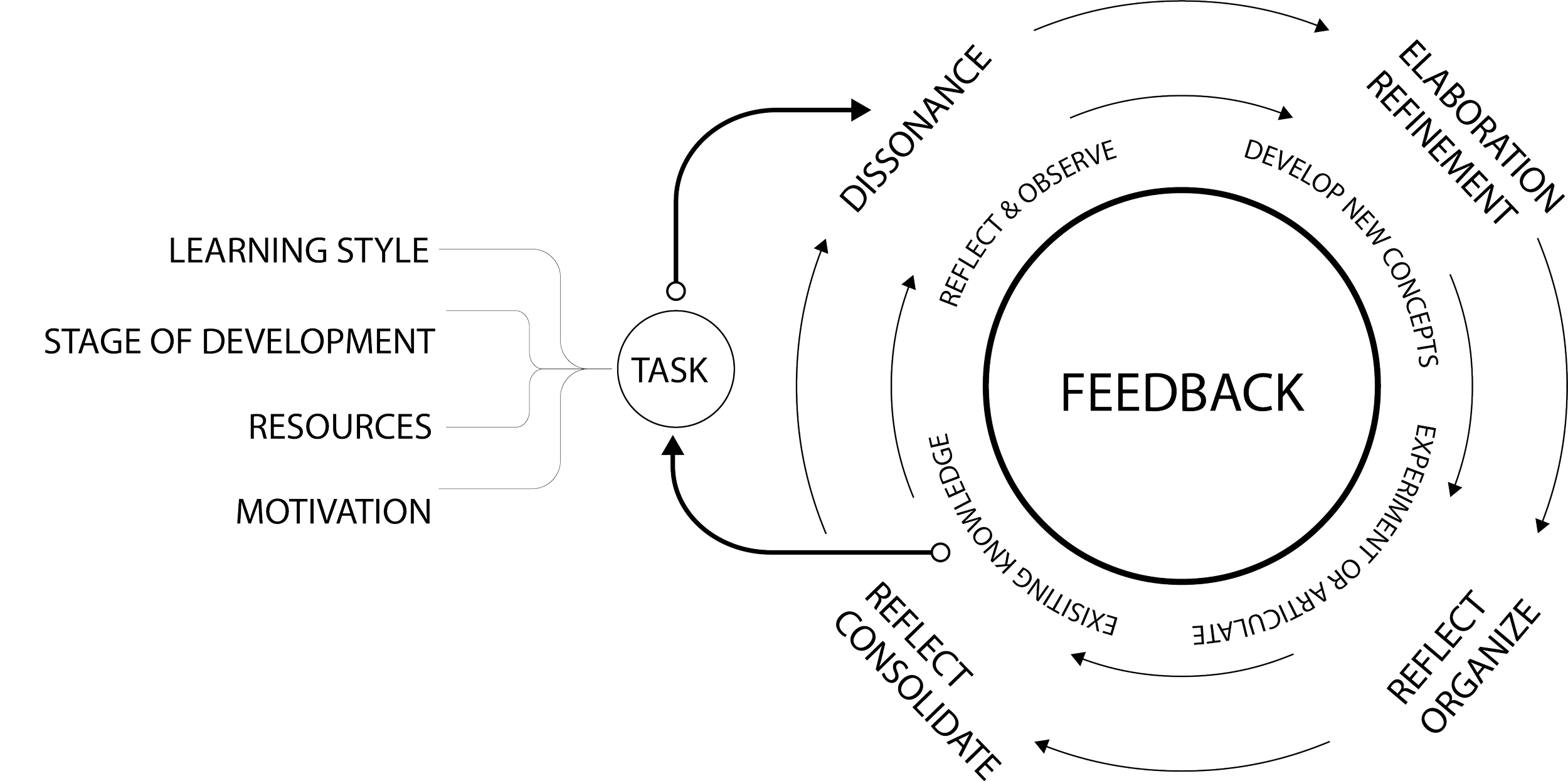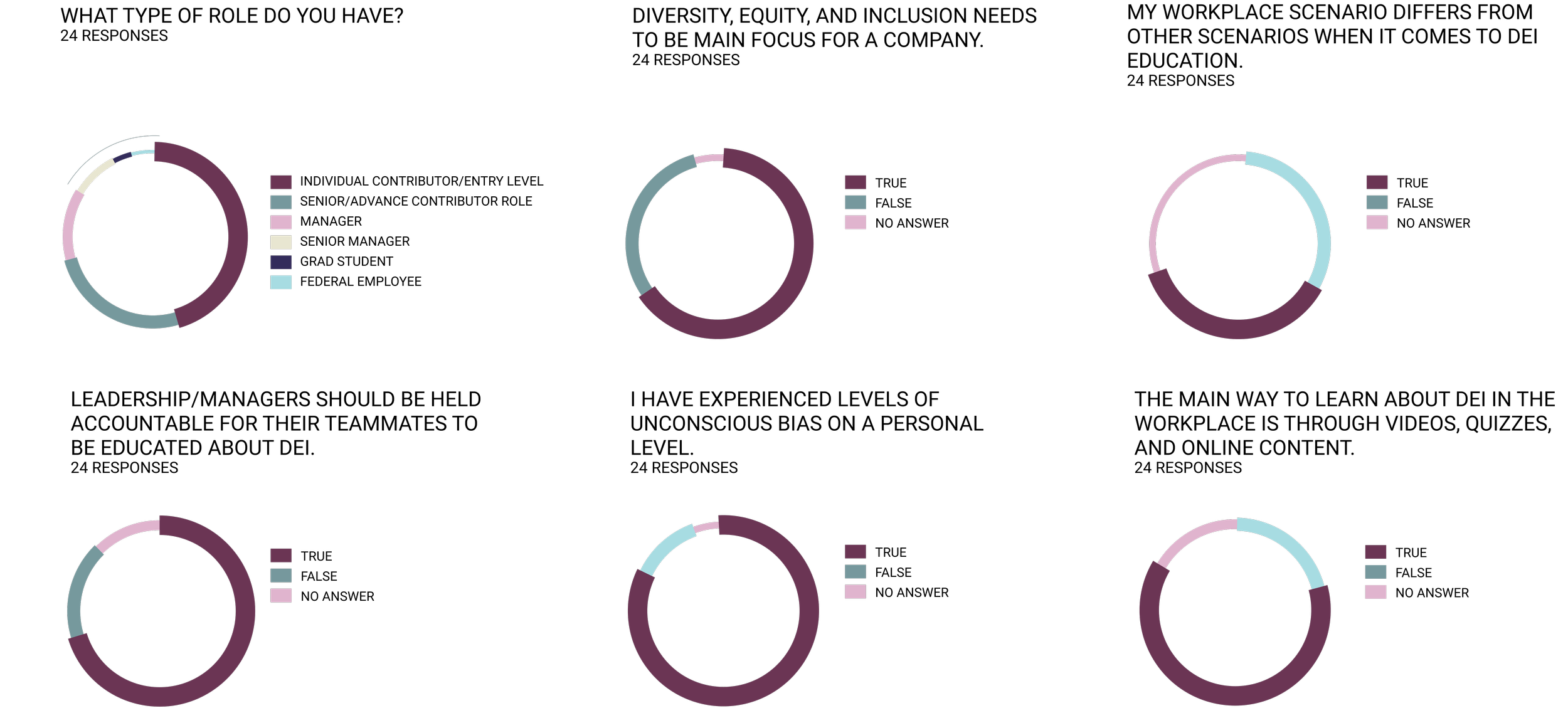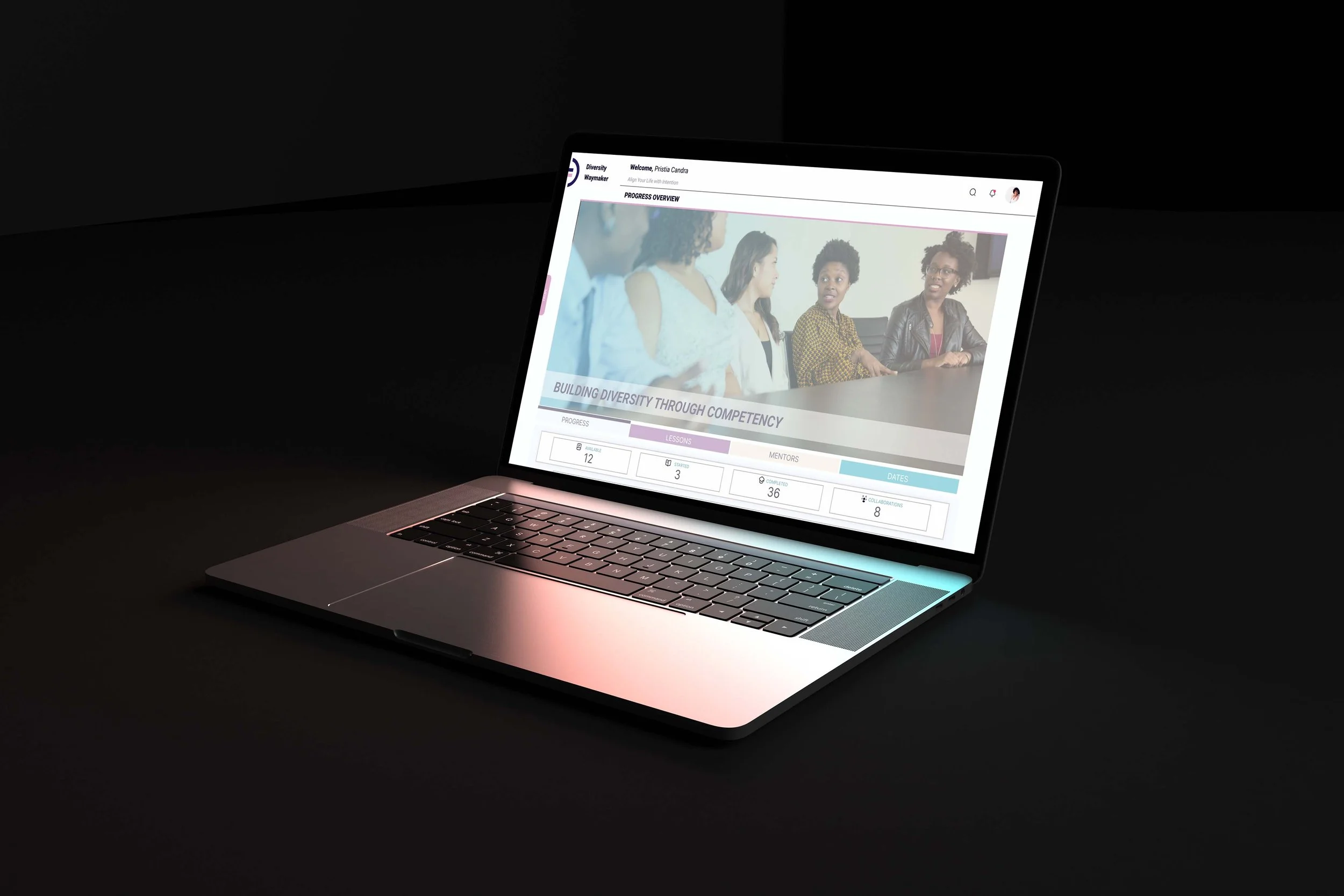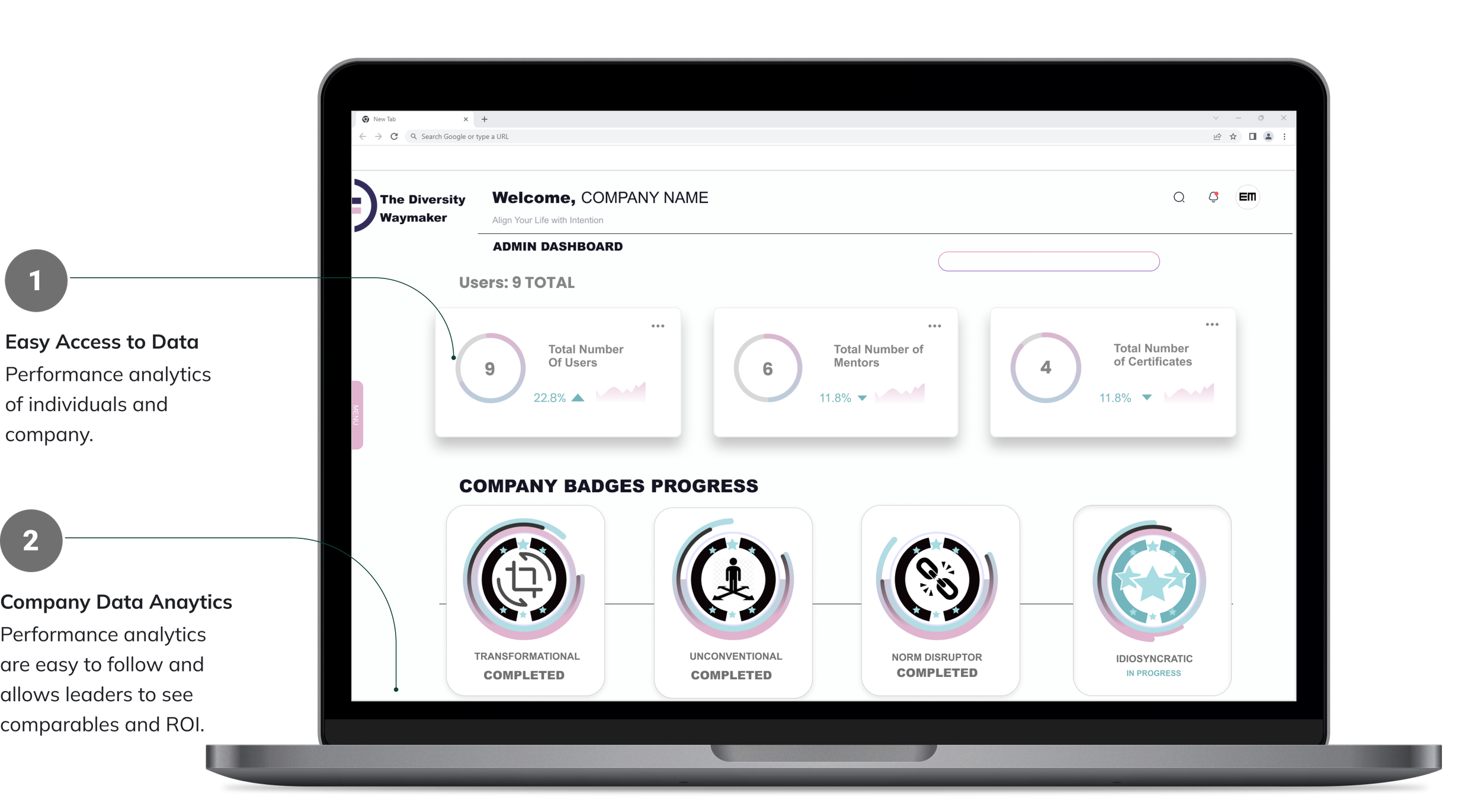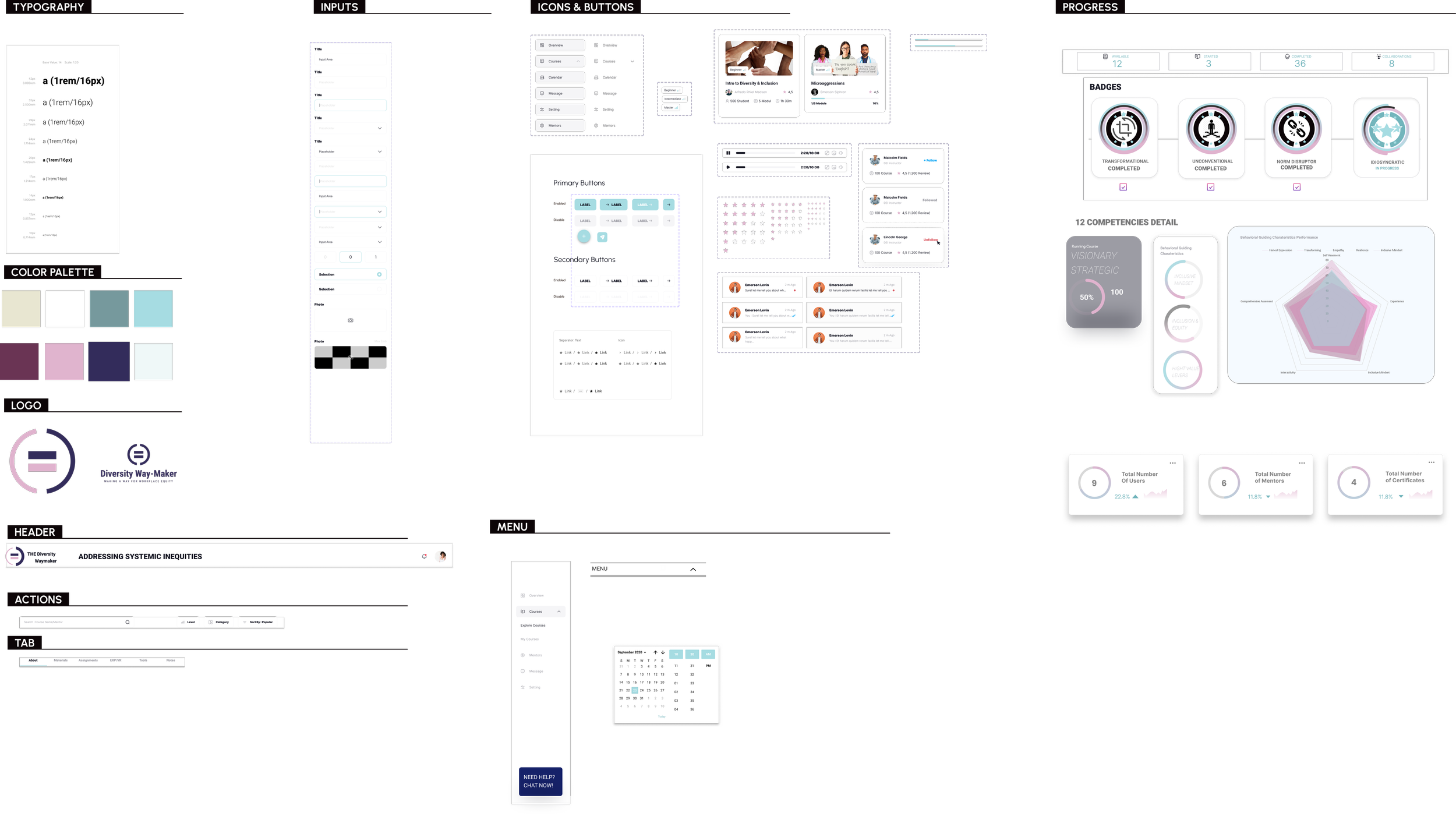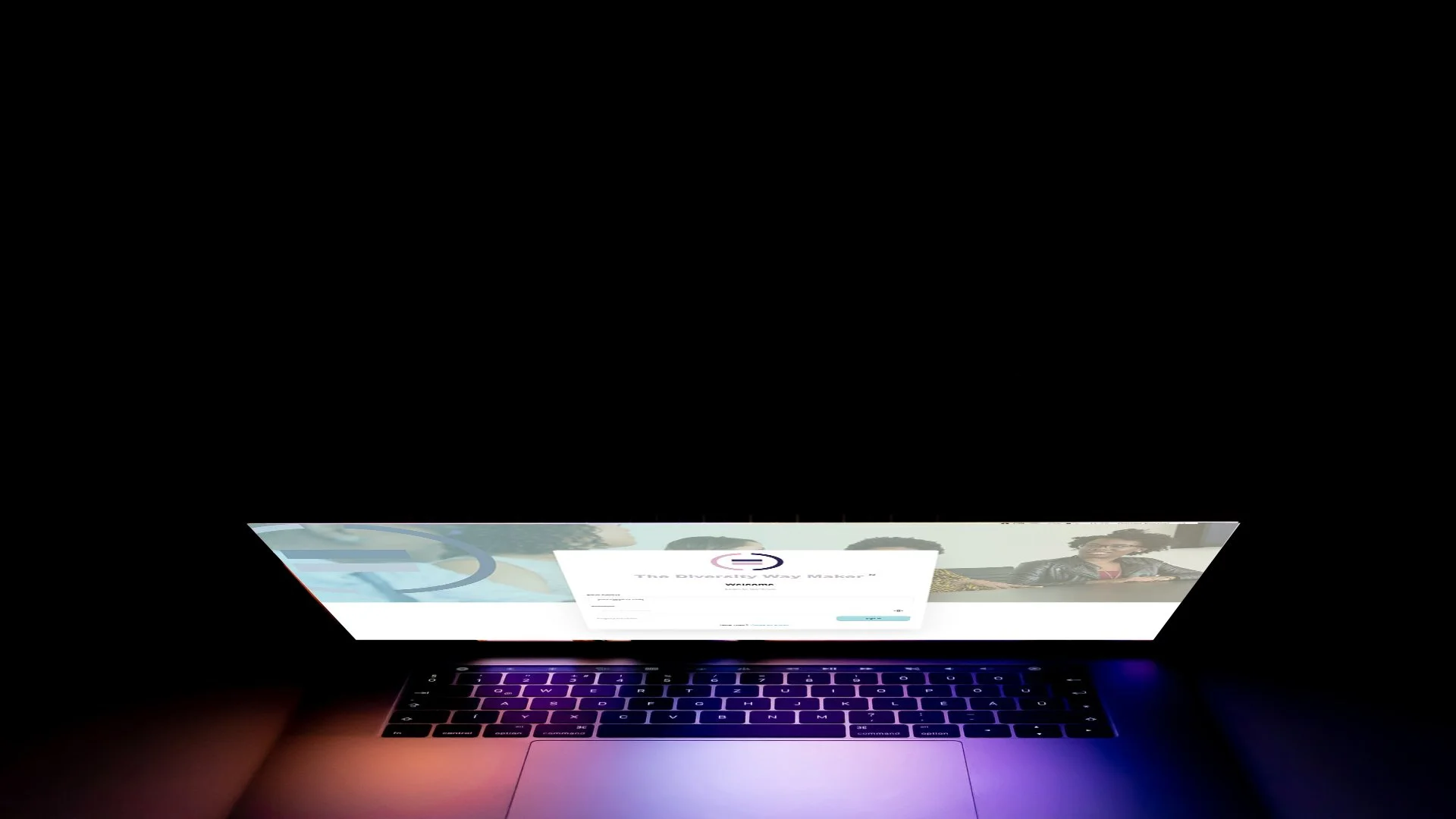
TIMEFRAME
2 Weeks Research
3 Weeks User Testing
2 Weeks Design
MY ROLE
UX Designer
Product Strategist
User Researcher
TOOLS
Figma
Illustrator
MIRO
MENTOR
Diego Salvatierra
In a world of increasing diversity, empathizing across barriers affect business performance and mitigates change. I worked with The founder of The Diversity WayMaker Consulting in partnership with WTIA (Washington Technology Industry Association) to create a prototype that would leverage critical drivers that promote diversity and impact positive business outcomes.

+ BACKGROUND +
Yolanda Chase, SHRM-SCP, CPM, CM, is the Director of Work(place) Forward and creator of The Diversity Way Maker Consulting, LLC. Her passion to develop programs seeks to help business leaders integrate DEI into their leadership and functional operations that create healthy, prosperous, inclusive work environments.
This project is focused on designing a prototype for a client, The Diversity Way Maker Consulting, to represent the core components of The Diversity Way-Maker™ digital learning platform.
CHALLENGES
The absence of diversity decreases a range of different experiences and increases the risk of blind spots in problem-solving and the likelihood of unconscious bias that in turn, impacts positive user experiences.
Economic differences are intersectional, and it is important to understand how solving for any part of an aggregate affects the entire body’s ability to achieve goals, reduce disparities, and find more ways to connect across differences.
Most importantly, understanding how to support is critical to sustainable outcomes. This means connecting business leaders to products that can be easily integrated into an existing enterprise structure and are accessible, relatable, and easy to use.
+ Background +
The client interview helped to determine the appropriate platform for the digital prototype that addresses the following with respect to the client and the expected users:
The platform must showcase the 12 competencies and definitions to end users.
It should enable leaders to integrate competencies into strategic DEI plans for C-suite, board, operations, talent management, and product development.
It must record performances, progress, and outcomes with respect to DEI training and ROI.
Clarify Objectives
*
After meeting with the client and team I refined my approach to prioritize key performance indicators.
*
Understand the value proposition of users and stakeholders to match the ideal product that meets user and business needs.
Discover users’ needs and pain points in the DEI training learning environment and experience for professional adult learners.
Analyze insights generated from users, competitor motivations, and responses to usability.
Determine various assets and design strategies that respond to values, needs, and pain points.
Validate the usability of the prototype and iterate to generate a valid proposal.
APPROACH
Clarify Objectives
*
My first task was to understand the scope and scale of diversity training through research on the topic of DEI training impacts.
So, I began by asking questions.
*
Clarify Objectives
*
DOES DEI TRAINING AFFECT
BUSINESS OUTCOMES?
*
+ QUALITATIVE SECONDARY RESEARCH +
Companies with 2-D diversity out-innovate and outperform competitors at a 45% increase in market share and are 70% more likely to capture new markets and increase innovation and retention (HBR) and diversity correlates with better financial performance, giving a 35% increase above a national industry median, by diversity quartile (McKinsey).
Diversity has been proven to be beneficial for business growth.
ANDRAGOGY
+ QUALITATIVE SECONDARY RESEARCH +
ANDRAGOGY
LEARNING CYCLE
I have identified a balanced approach through blended learning methods modeled by pioneers in andragogy.
Blended Learning Journey: Best Practices for Adult Learners
Adult learners have specific needs and requirements to get the most out of their education. from my secondary qualitative research, I utilize the fundamental principles theorized by Malcolm Knowles, Eduard C. Lindeman, and Taylor and Hamady categorization, into a learners journey. The elements include self-directed, experiential learning, immediate application, and internal/external motivators applied in the porotype architecture and experience.
Individualized tasks and resources can help achieve the best learning outcomes possible.
Limitations to acquiring new knowledge according to the Johari Window, occur in “blind spots” between “unknown unknowns” and not known to self but known through others, however, can be overcome through a transformative learning approach. Utilizing the Kolb Cycle (1984) integrated with Bloom’s taxonomy which focuses on reflection on action.
02 / DISCOVER THE USERS NEEDS
+ QUANTITATIVE PRIMARY RESEARCH +
WHO ARE THE USERS AND WHAT DO THEY NEED?
To understand the nuances in adult education and training, and to optimize an approach that addresses the end users needs, goals, and pain points, and misconceptions, my team and I coordinated a study to on DEI training, impacts, and coordinated a survey to gauge what users would want from a DEI platform.
03 / ANALYIZE INSIGHTS FROM USERS
Users would prefer an interactive experience such as in-person training and monitoring progress to see the immediate impacts and ROI and business goals.
+ KEY INSIGHTS +
+ KEY INSIGHTS +
Most users are afraid of being misunderstood and ostracized for lack of knowledge on specific topics related to DEI and thus shy away from it.
From the kick-off meeting, surveys, and interviews, I have determined the target users that would benefit most from the platform and would have the greatest impact on business outcomes.
Target Users
+ IDENTIFY USERS +
04 / DETERMINE ASSETS
+ USER TESTING +
+ PHASE I +
Following several iterations of sketches, I designed wireframes to test the organization and the initial flow of pages to test.
Responses on the wireframes were based on key flows such as navigating to the dashboard, course content, and the sign-in process. To process and reframe the insights that I categorized into opportunity areas to discover possible solutions that could potentially improve revenue outcomes by 25% - 35%
USER RESPONSES
Responses based on the wireframes of key flows such as navigating to the dashboard, course content, and sign in process. Most responses were on UI design, and ease of navigation. The average rating of the wireframe was 3.08 out of 5.
+ VALIDATE USABILITY +
+ INFORMATION ARCHITECTURE +
To clarify the user flow and organize the immersive learning cycle, I structured the scope of the user platform.
The featured pages and task flows correspond to Klob’s Cycle and Bloom’s Taxonomy.
05/ VALIDATE // USER TESTING // PROTOTYPING
PROTOTYPING
Following feedback from user testing, I quickly moved into high-fidelity prototyping and testing.
+ VALIDATE USABILITY +
*
After organizing the structure of the user learning cycle and journey and testing the user flow, I presented the prototype to the client and hand-off the design documentation set that highlighted key features.
*
+ PHASE 2 PROTOTYPING + USER TESTING +
[DASHBOARD]
The dashboard is the first screen after the onboarding/sign-in process. It is designed to allow the User to view a snapshot of their progress and perform immediate tasks such as scheduling, navigating to courses, etc. More details are provided below.
The core competencies are designed as progress badges that visually complete each stage by completing the concentric circles. Once the core competencies are complete a check mark indicates completion.
A detailed view displays tasks to complete in each badge and a radar chart that allows users to see behavioral change indicators outlined by The Diversity Way-Maker Consulting LLC.
Onboarding customizes user’s learning journey.
The onboarding process takes users through a series of questions that store results in an LRS system that informs the xAPI, creating a unique learning track for each individual user based on their areas of strengths and opportunities for improvement.
A customized selection of courses, game levels, and mentors.
Creates personalized learning that fits the exact needs of the users and displays KPIs through the dashboard so users can keep track of their performance.
Management and leadership onboarding process assesses the needs of the company and creates KPIs based on individual employee learning journeys and displays data analytics in a comprehensive easy-to-use dashboard.
Direct Feedback through simulation.
Through VR simulations, the LMS gathers information about the users performance and comprehension of foundational concepts through simulated gamified interactive challenges. A key feature is the ability to live chat with a mentor through scenarios, interact with other live users, and apply key concepts in real time.
Mentors are able to suggest courses based on data from simulations.
Users that are new to the ideas of diversity can learn in a safe, nonjudgmental environment.
Allows management to precisely target performance
factors that lead to success.
Connect with others.
One of the main challenges facing diversity is that not everyone has the ability to learn outside of their immediate environment. Users can schedule time with mentors, interact live with mentors and peers through gamified VR experiences, and send messages to other users and mentors.
Creates a sense of community and allows more realistic interactions in a safe environment.
Expands user’s environment and experience with others from different backgrounds
Effective learning through the application of concepts in real-time and through experience.
Management View
Enterprises can monitor company's progress of the core competencies among employees and ROI through an easily - accessible interface.
Company badges provide a competitive edge and help prospective employees identify investment in DEI.
Features also allow managers to keep track of individual performances on assignments and simulations.
Performance analytics and data are easy to follow and allows leaders to see the direct impacts of DEI training overtime through comparables.
Now its your turn.
+ USER JOURNEY MAP +
+ STYLE GUIDE +
TAKE AWAYS:
Create a safe and non-judgmental environment.
Some of the main challenges that I encountered throughout the research and feedback from user testing was the desire to be understood without judgment. Providing a safe platform that allowed application through immersive learning was critical to advancing knowledge of the 12 competencies.
Understanding Constraints
Through careful research and applying user insights, I believe that several more iterations could help to refine the user platform. I learned from the client what was feasible, and what could remain theoretical due to some technical constraints, such as the exploration of AI applications. However, as a designer, I had to learn the assumptions and process of how customized learning can be achieved yet remain hypothetical.
Generating empathy through a digital platform.
Working directly with the client who had extensive experience using the immersive learning process through workshops, it was helpful to think about how to transform in real-life experience into a digital one that maintains social interaction. From this project I learned how to see a challenging experience of an often contentious topic from all points of view to create an experience that is inclusive and unique.






